Dynamic Polarization Patterning Technique for High-Quality Liquid Crystal Planar Optics
Abstract
:1. Introduction
2. Experimental Details
3. Results and Discussion
4. Conclusions
Author Contributions
Funding
Institutional Review Board Statement
Informed Consent Statement
Data Availability Statement
Conflicts of Interest
References
- Komanduri, R.K.; Escuti, M.J. High efficiency reflective liquid crystal polarization gratings. Appl. Phys. Lett. 2009, 95, 091106. [Google Scholar] [CrossRef]
- Lin, T.; Xie, J.; Zhou, Y.; Zhou, Y.; Yuan, Y.; Fan, F.; Wen, S. Recent advances in photoalignment liquid crystal polarization gratings and their applications. Crystals 2021, 11, 900. [Google Scholar] [CrossRef]
- De Sio, L.; Tabiryan, N.; McConney, M.; Bunning, T.J. Cycloidal diffractive waveplates fabricated using a high-power diode-pumped solid-state laser operating at 532 nm. J. Opt. Soc. Am. B 2019, 36, D136–D139. [Google Scholar] [CrossRef]
- Tabiryan, N.V.; Serak, S.V.; Nersisyan, S.R.; Roberts, D.E.; Zeldovich, B.Y.; Steeves, D.M.; Kimball, B.R. Broadband waveplate lenses. Opt. Express 2016, 24, 7091–7102. [Google Scholar] [CrossRef] [PubMed]
- Serak, S.V.; Roberts, D.E.; Hwang, J.Y.; Nersisyan, S.R.; Tabiryan, N.V.; Bunning, T.J.; Steeves, D.M.; Kimball, B.R. Diffractive waveplate arrays. J. Opt. Soc. Am. B 2017, 34, B56–B63. [Google Scholar] [CrossRef]
- Yu, H.; Zhou, Z.; Qi, Y.; Zhang, X.; WEI, Q.H. Pancharatnam–Berry optical lenses. J. Opt. Soc. Am. B 2019, 36, D107–D111. [Google Scholar] [CrossRef]
- Feng, W.; Liu, Z.; Liu, H.; Ye, M. Design of tunable liquid crystal lenses with a parabolic phase profile. Crystals 2022, 13, 8. [Google Scholar] [CrossRef]
- Chen, P.; Ma, L.L.; Duan, W.; Chen, J.; Ge, S.J.; Zhu, Z.H.; Tang, M.J.; Xu, R.; Gao, W.; Li, T.; et al. Digitalizing self-assembled chiral superstructures for optical vortex processing. Adv. Mater. 2018, 30, 1705865. [Google Scholar] [CrossRef] [PubMed]
- Duan, W.; Chen, P.; Ge, S.J.; Wei, B.Y.; Hu, W.; Lu, Y.Q. Helicity-dependent forked vortex lens based on photo-patterned liquid crystals. Opt. Express 2017, 25, 14059–14064. [Google Scholar] [CrossRef] [PubMed]
- Chen, P.; Wei, B.Y.; Hu, W.; Lu, Y.Q. Liquid-Crystal-Mediated Geometric Phase: From Transmissive to Broadband Reflective Planar Optics. Adv. Mater. 2020, 32, 1903665. [Google Scholar] [CrossRef] [PubMed]
- Tabiryan, N.V.; Roberts, D.E.; Liao, Z.; Hwang, J.Y.; Moran, M.; Ouskova, O.; Pshenichnyi, A.; Sigley, J.; Tabirian, A.; Vergara, R.; et al. Advances in Transparent Planar Optics: Enabling Large Aperture, Ultrathin Lenses. Adv. Opt. Mater. 2021, 9, 2001692. [Google Scholar] [CrossRef]
- Li, S.; Liu, Y.; Li, Y.; Liu, S.; Chen, S.; Su, Y. Fast-response Pancharatnam-Berry phase optical elements based on polymer-stabilized liquid crystal. Opt. Express 2019, 27, 22522–22531. [Google Scholar] [CrossRef] [PubMed]
- De Sio, L.; Roberts, D.E.; Liao, Z.; Nersisyan, S.; Uskova, O.; Wickboldt, L.; Tabiryan, N.; Steeves, D.M.; Kimball, B.R. Digital polarization holography advancing geometrical phase optics. Opt. Express 2016, 24, 18297–18306. [Google Scholar] [CrossRef] [PubMed]
- Li, Y.; Zhan, T.; Wu, S.T. Flat cholesteric liquid crystal polymeric lens with low f-number. Opt. Express 2020, 28, 5875–5882. [Google Scholar] [CrossRef] [PubMed]
- Zhan, T.; Lee, Y.H.; Wu, S.T. High-resolution additive light field near-eye display by switchable Pancharatnam–Berry phase lenses. Opt. Express 2018, 26, 4863–4872. [Google Scholar] [CrossRef] [PubMed]
- Zhan, T.; Xiong, J.; Lee, Y.H.; Wu, S.T. Polarization-independent Pancharatnam-Berry phase lens system. Opt. Express 2018, 26, 35026–35033. [Google Scholar] [CrossRef] [PubMed]
- Yin, K.; Xiong, J.; He, Z.; Wu, S.T. Patterning liquid-crystal alignment for ultrathin flat optics. ACS Omega 2020, 5, 31485–31489. [Google Scholar] [CrossRef] [PubMed]
- Ying, J.; Zheng, J. Fingerprint sensor using a polymer dispersed liquid crystal holographic lens. Appl. Opt. 2010, 49, 4763–4766. [Google Scholar]
- Zhang, X.J.; Zhou, X.; Yang, Z.X.; Zhang, L.X.; Huang, W.; Chen, L. High-throughput and controllable manufacturing of liquid crystal polymer planar microlens array for compact fingerprint imaging. Opt. Express 2022, 30, 3101–3112. [Google Scholar] [CrossRef] [PubMed]
- Xiong, J.; Hsiang, E.L.; He, Z.; Zhan, T.; Wu, S.T. Augmented reality and virtual reality displays: Emerging technologies and future perspectives. Light. Sci Appl. 2021, 10, 216. [Google Scholar] [CrossRef] [PubMed]
- Yin, K.; Hsiang, E.L.; Zou, J.; Li, Y.; Yang, Z.; Yang, Q.; Lai, P.C.; Lin, C.L.; Wu, S.T. Advanced liquid crystal devices for augmented reality and virtual reality displays: Principles and applications. Light. Sci Appl. 2022, 11, 161. [Google Scholar] [CrossRef] [PubMed]
- Zhao, X.; Bermak, A.; Boussaid, F.; Chigrinov, V.G. Liquid-crystal micropolarimeter array for full Stokes polarization imaging in visible spectrum. Opt. Express 2010, 18, 17776–17787. [Google Scholar] [CrossRef] [PubMed]
- Yang, Z.X.; Shou, Q.L.; Zhou, X.; Zhang, X.J.; Huang, W.; Chen, L. Wide field of view chiral imaging with a liquid crystal planar lens enabled by digitalized nanogratings. Opt. Express 2022, 30, 44864–44877. [Google Scholar] [CrossRef] [PubMed]
- García de Blas, M.; Geday, M.A.; Otón, J.M.; Arregui, X.Q. Two-dimensional digital beam steering based on liquid crystal phase gratings. Appl. Sci. 2021, 11, 3632. [Google Scholar] [CrossRef]
- Gou, F.; Peng, F.; Ru, Q.; Lee, Y.H.; Chen, H.; He, Z.; Zhan, T.; Vodopyanov, K.L.; Wu, S.T. Mid-wave infrared beam steering based on high-efficiency liquid crystal diffractive waveplates. Opt. Express 2017, 25, 22404–22410. [Google Scholar] [CrossRef]
- Slussarenko, S.; Francescangeli, O.; Simoni, F. High resolution polarization gratings in liquid crystals. Appl. Phys. Lett. 1997, 71, 3613–3615. [Google Scholar] [CrossRef]
- Zhan, T.; Xiong, J.; Lee, Y.H.; Chen, R.; Wu, S.T. Fabrication of Pancharatnam-Berry phase optical elements with highly stable polarization holography. Opt. Express 2019, 27, 2632–2642. [Google Scholar] [CrossRef]
- He, Z.; Yin, K.; Wu, S.T. Standing wave polarization holography for realizing liquid crystal Pancharatnum-Berry phase lenses. Opt. Express 2020, 28, 21729–21736. [Google Scholar] [CrossRef] [PubMed]
- Presnyakov, V.; Asatryan, K.; Galstian, T.; Chigrinov, V. Optical polarization grating induced liquid crystal micro-structure using azo-dye command layer. Opt. Express 2006, 14, 10558–10564. [Google Scholar] [CrossRef] [PubMed]
- Wu, H.; Hu, W.; Hu, H.C.; Lin, X.W.; Zhu, G.; Choi, J.W.; Chigrinov, V.; Lu, Y.Q. Arbitrary photo-patterning in liquid crystal alignments using DMD based lithography system. Opt. Express 2012, 20, 16684–16689. [Google Scholar] [CrossRef]
- Duan, W.; Chen, P.; Ge, S.J.; Liang, X.; Hu, W. A fast-response and helicity-dependent lens enabled by micro-patterned dual-frequency liquid crystals. Crystals 2019, 9, 111. [Google Scholar] [CrossRef]
- Miskiewicz, M.N.; Escuti, M.J. Direct-writing of complex liquid crystal patterns. Opt. Express 2014, 22, 12691–12706. [Google Scholar] [CrossRef] [PubMed]
- Miskiewicz, M.N.; Escuti, M.J. Optimization of direct-write polarization gratings. Opt. Eng. 2015, 54, 025101. [Google Scholar] [CrossRef]
- Kim, J.; Li, Y.; Miskiewicz, M.N.; Oh, C.; Kudenov, M.W.; Escuti, M.J. Fabrication of ideal geometric-phase holograms with arbitrary wavefronts. Optica 2015, 2, 958–964. [Google Scholar] [CrossRef]
- Meng, Z.; Huang, W.; Zhang, L.X.; Zhou, X.; Zhao, K.; Pu, D.; Chen, L. Large aperture and defect-free liquid crystal planar optics enabled by high-throughput pulsed polarization patterning. Opt. Express 2023, 31, 30435–30445. [Google Scholar] [CrossRef] [PubMed]
- Miyamoto, K. The phase Fresnel lens. J. Opt. Soc. Am. 1961, 51, 17–20. [Google Scholar] [CrossRef]
- Honma, M.; Nose, T. Liquid-crystal Fresnel zone plate fabricated by microrubbing. Jpn. J. Appl. Phys. 2005, 44, 287. [Google Scholar] [CrossRef]
- Xu, Q.; Sun, T.; Wang, C. Coded liquid crystal metasurface for achromatic imaging in the broadband wavelength range. ACS Appl. Nano. Mater. 2021, 4, 5068–5075. [Google Scholar] [CrossRef]

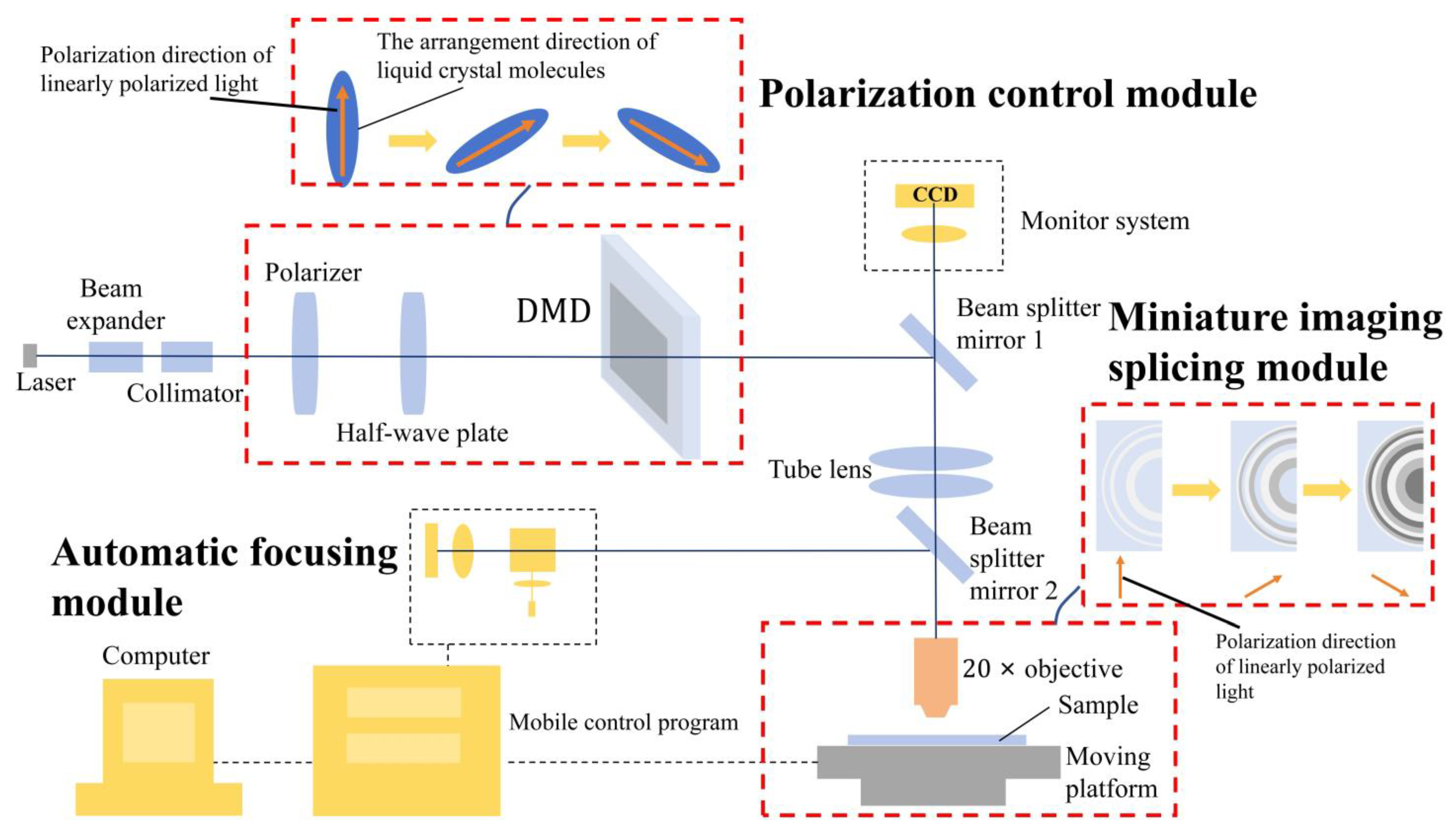

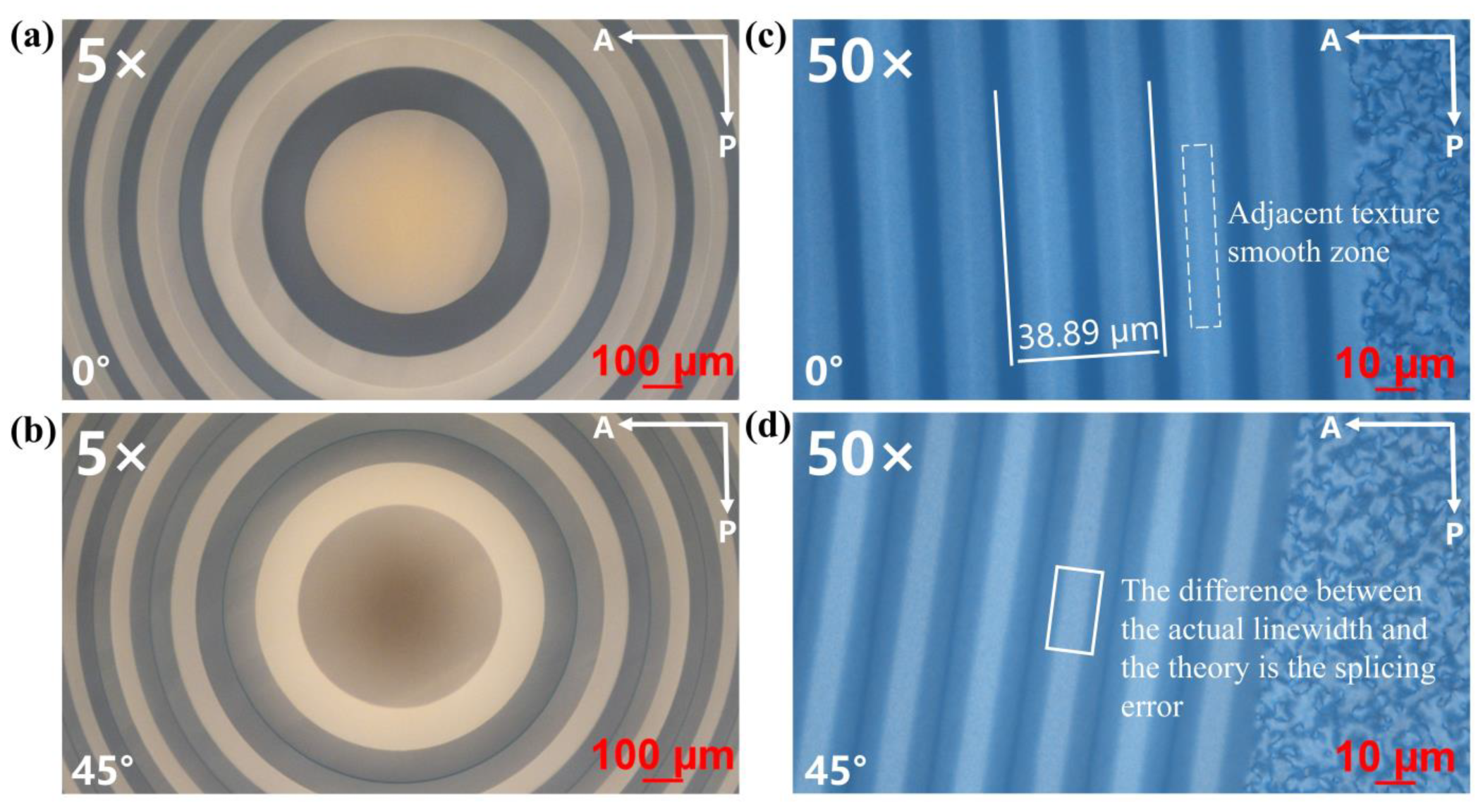
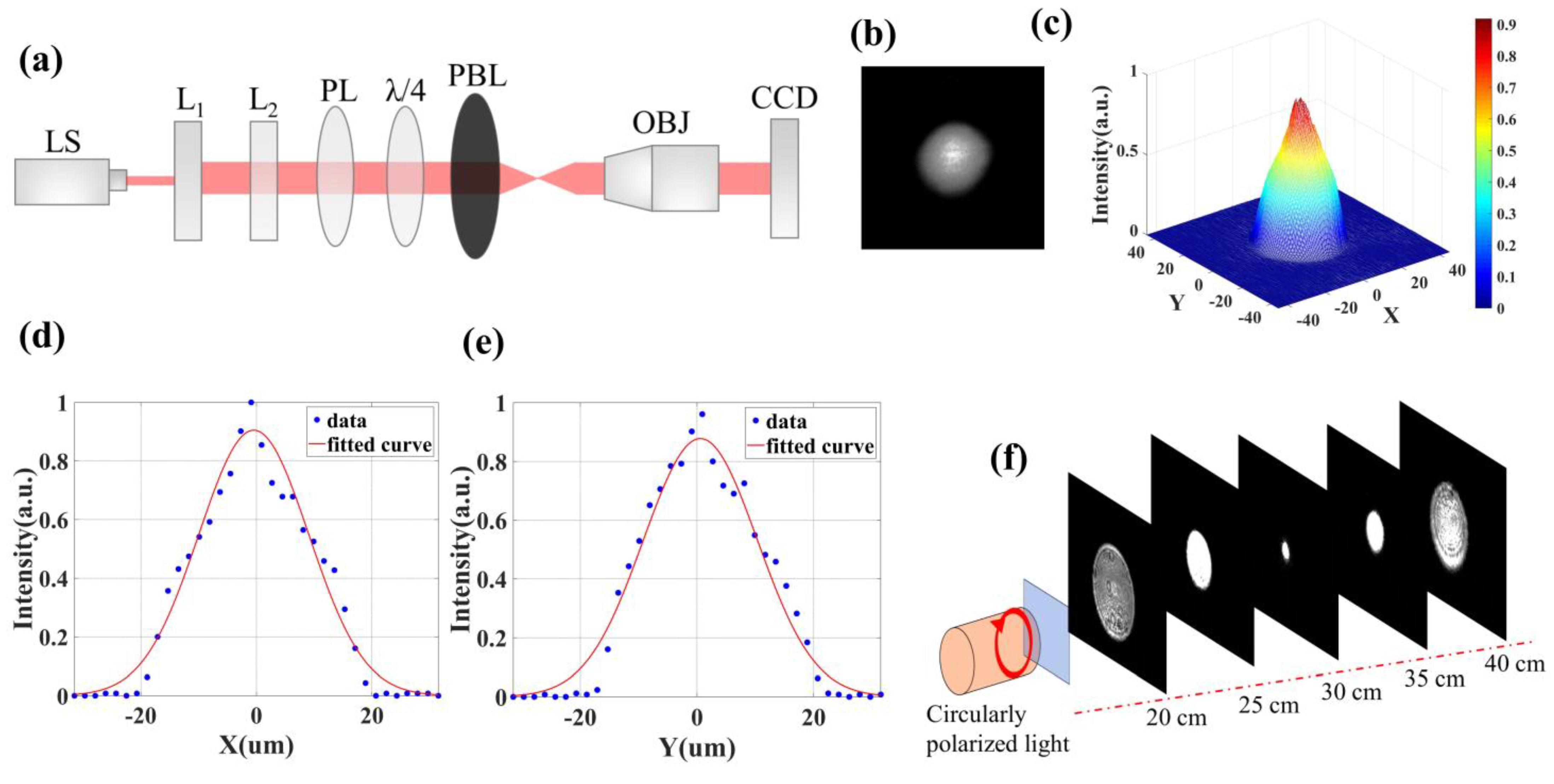
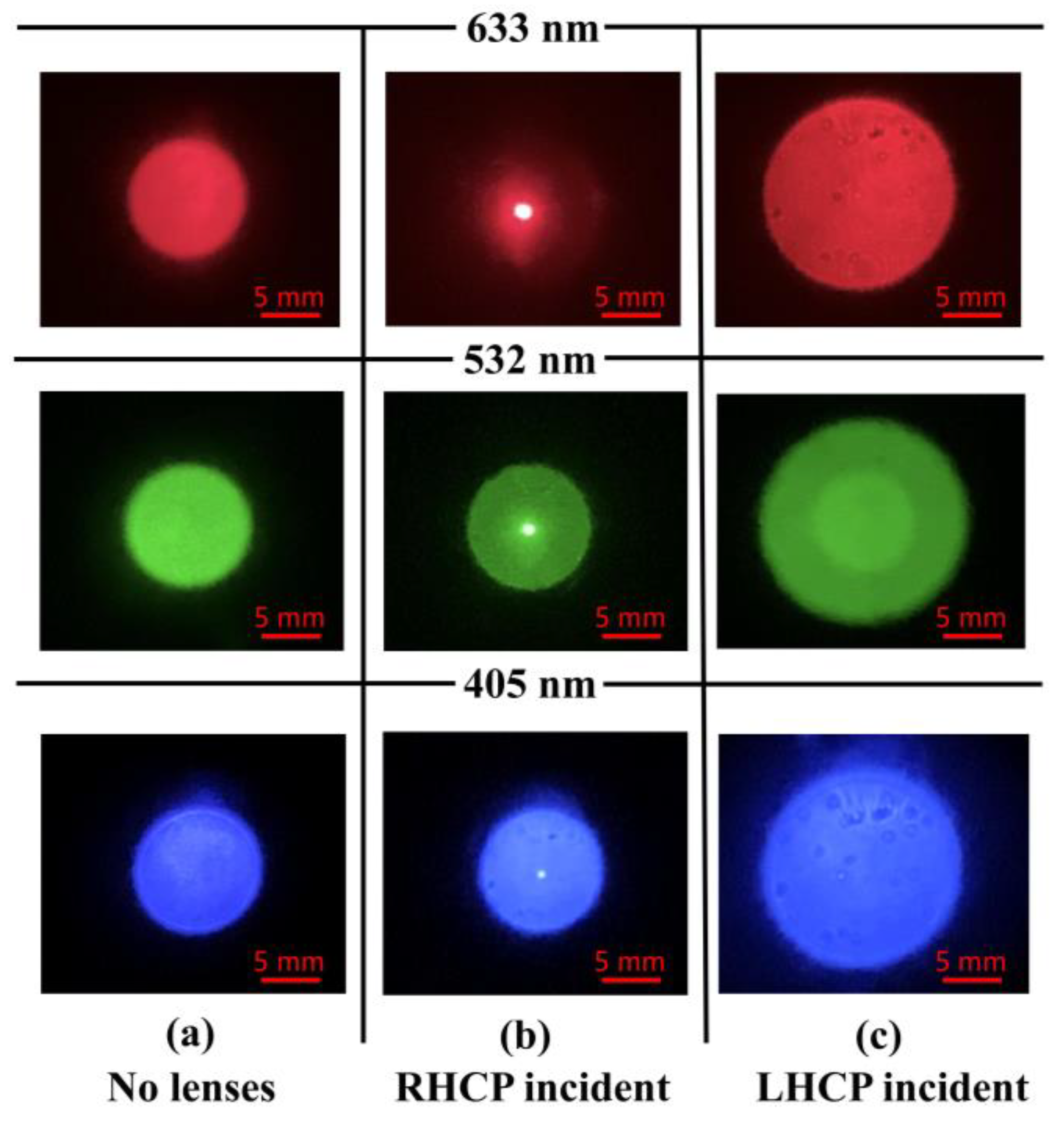
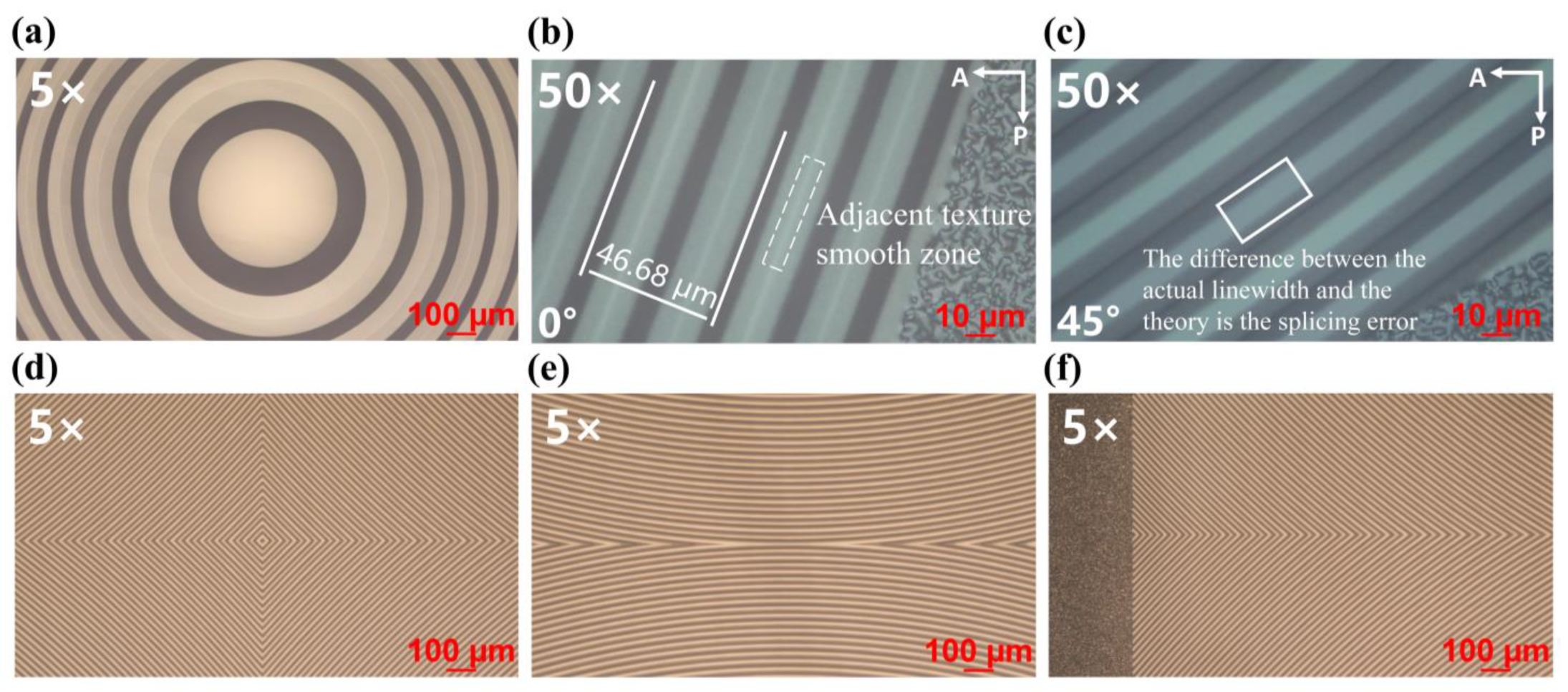

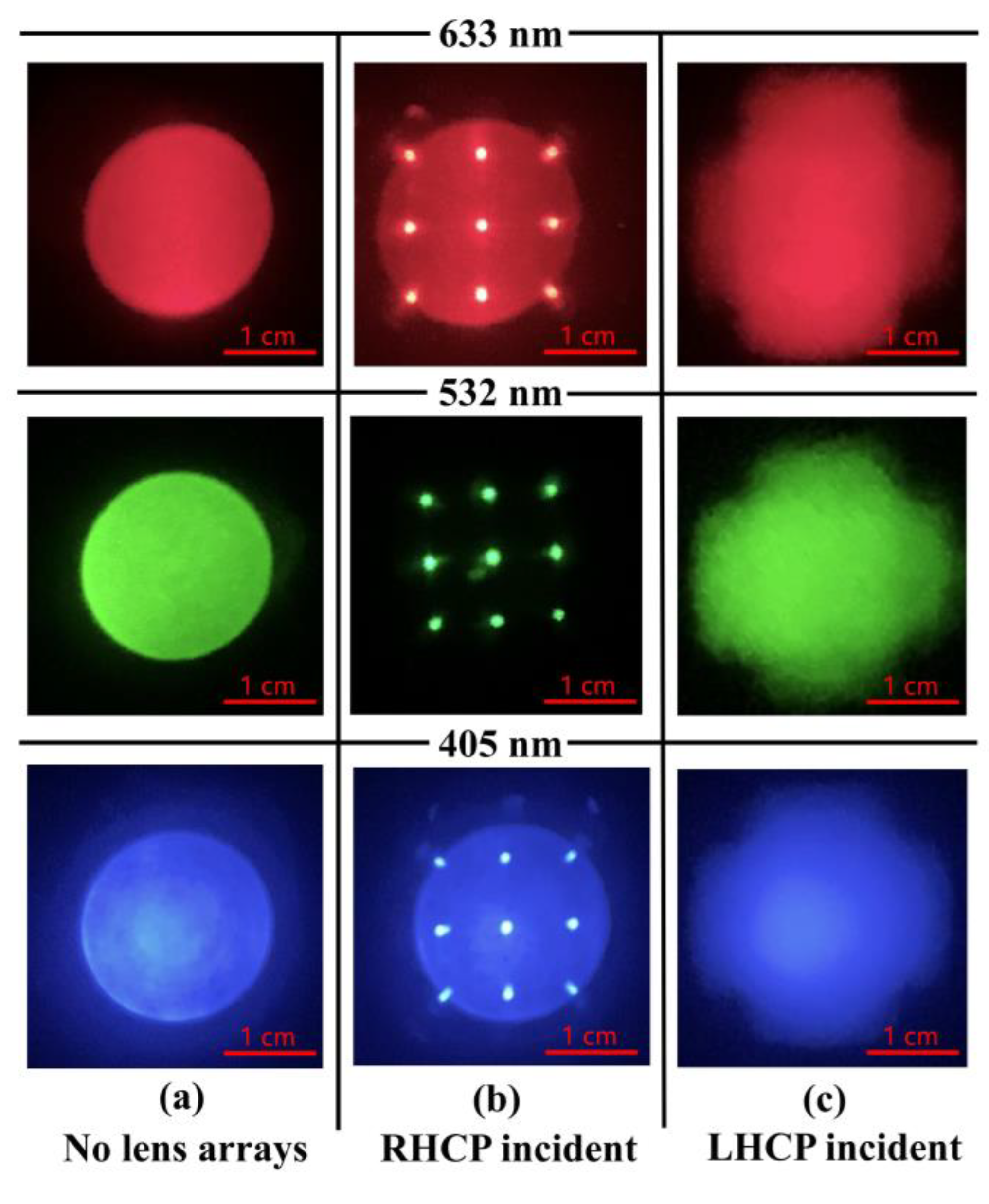
Disclaimer/Publisher’s Note: The statements, opinions and data contained in all publications are solely those of the individual author(s) and contributor(s) and not of MDPI and/or the editor(s). MDPI and/or the editor(s) disclaim responsibility for any injury to people or property resulting from any ideas, methods, instructions or products referred to in the content. |
© 2024 by the authors. Licensee MDPI, Basel, Switzerland. This article is an open access article distributed under the terms and conditions of the Creative Commons Attribution (CC BY) license (https://creativecommons.org/licenses/by/4.0/).
Share and Cite
Qin, X.; Zhao, K.; Zhang, X.-j.; Zhou, X.; Huang, W.; Chen, L. Dynamic Polarization Patterning Technique for High-Quality Liquid Crystal Planar Optics. Photonics 2024, 11, 350. https://doi.org/10.3390/photonics11040350
Qin X, Zhao K, Zhang X-j, Zhou X, Huang W, Chen L. Dynamic Polarization Patterning Technique for High-Quality Liquid Crystal Planar Optics. Photonics. 2024; 11(4):350. https://doi.org/10.3390/photonics11040350
Chicago/Turabian StyleQin, Xinwei, Keyang Zhao, Xin-jun Zhang, Xiaohong Zhou, Wenbin Huang, and Linsen Chen. 2024. "Dynamic Polarization Patterning Technique for High-Quality Liquid Crystal Planar Optics" Photonics 11, no. 4: 350. https://doi.org/10.3390/photonics11040350




